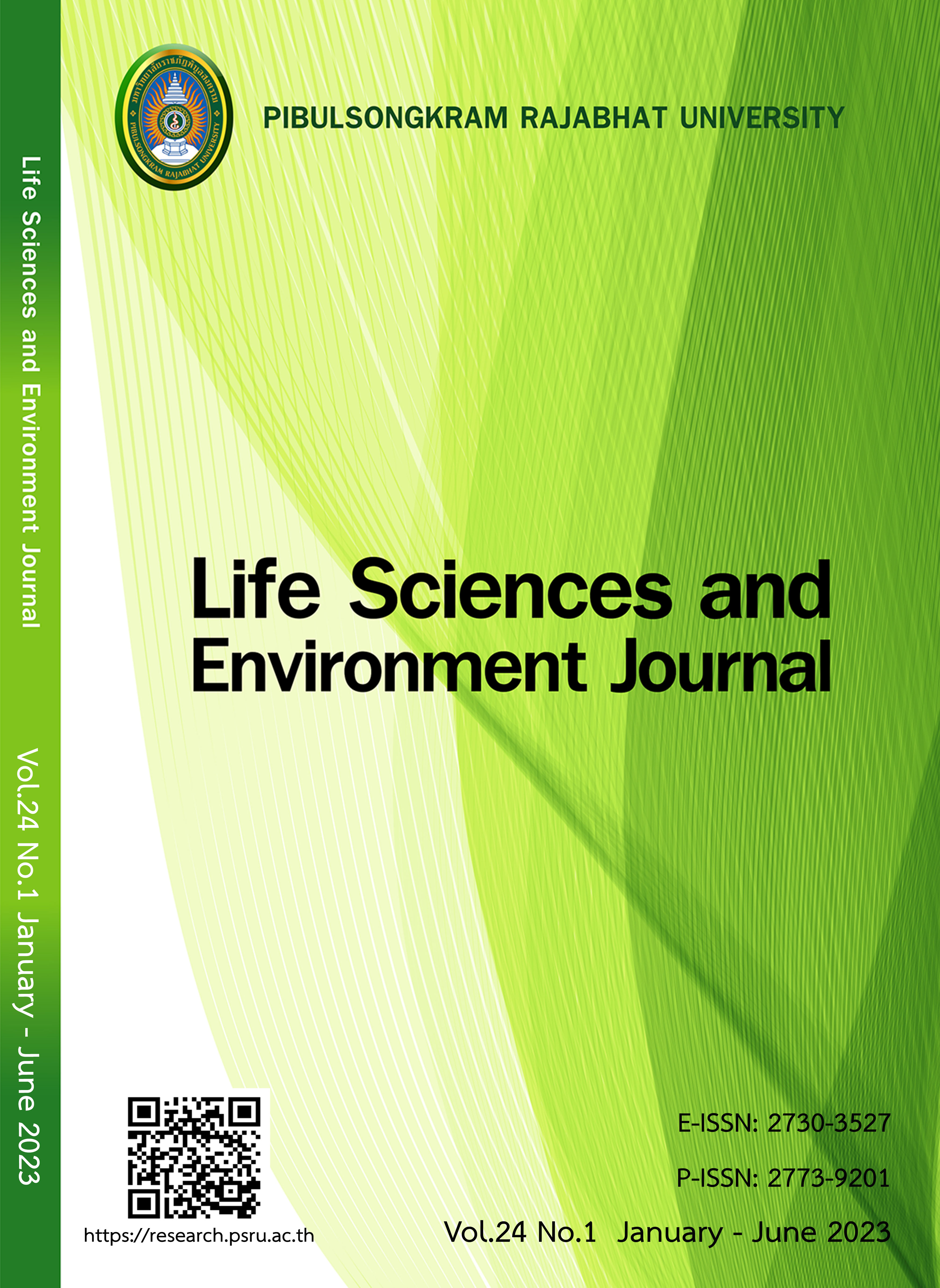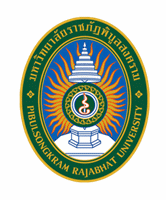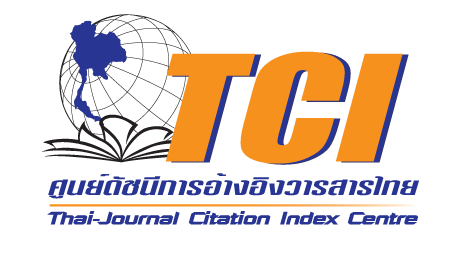การศึกษาการเพาะเลี้ยงยีสต์จากเศษเหลือกล้วยตาก เพื่อใช้เป็นสารเสริมในอาหารสัตว์
DOI:
https://doi.org/10.14456/lsej.2023.10บทคัดย่อ
การวิจัยครั้งนี้มีวัตถุประสงค์ เพื่อศึกษาการเพาะเลี้ยงยีสต์จากเศษเหลือกล้วยตาก
เพื่อใช้เป็นสารเสริมในอาหารสัตว์ โดยทำการเพาะเลี้ยงยีสต์จากเศษเหลือที่ได้จากการผลิตกล้วยตากจากการคัดทิ้งและผสมน้ำกลั่นในอัตราสวนทั้งหมด 5 ทรีทเมนต์ ได้แก่ 1:2 1:4 1:6 1:8 และ 1:10 ตามลำดับ ทำการเติมเบเกอร์ยีสต์ (Baker yeast) สายพันธุ์ Saccharomyces cerevisiae จำนวน 1 กรัม ลงไปในส่วนผสมของแต่ละทรีทเมนต์ จำนวน 100 กรัม แล้วนำไปบ่มที่อ่างน้ำควบคุมอุณหภูมิแบบเขย่า 100 รอบต่อนาที ที่ 30 องศาเซลเซียสเป็นระยะเวลา 72 ชั่วโมง หลังจากนั้นจึงทำการนับจำนวนเชื้อยีสต์ที่ได้จากการเพาะเลี้ยงโดยวิธีการเกลี่ยเชื้อ (Spread plate) จากผลการศึกษาพบว่า จำนวนยีสต์เพิ่มขึ้นตามอัตราส่วนของน้ำที่เพิ่มขึ้น โดยการเพาะเลี้ยงยีสต์จากเศษเหลือของกล้วยตากและน้ำในอัตราส่วน 1:10 มีการผลิตจำนวนยีสต์ได้มากที่สุด (6.60 × 107 cfu/g) รองลงมา ได้แก่ อัตราส่วน 1:8 (6.10 × 107 cfu/g)
1:6 (5.40 × 107 cfu/g) 1:4 (4.80 × 107 cfu/g) และ 1:2 (7.34 × 106 cfu/g) ตามลำดับ การศึกษาครั้งนี้ สรุปได้ว่าการนำเศษเหลือที่ได้จากการผลิตกล้วยตากมาผสมรวมกับน้ำกลั่นที่อัตราส่วน 1:10 สามารถเพิ่มปริมาณเซลล์ยีสต์ได้สูงสุด ซึ่งอาจเป็นอีกหนึ่งแนวทางในการเพิ่มมูลค่าและการใช้ประโยชน์จากเศษเหลือทางการเกษตรโดยการนำมาผลิตเป็นยีสต์มีชีวิตเพื่อใช้เป็นสารเสริมในอาหารสัตว์ต่อไปในอนาคต
เอกสารอ้างอิง
AOAC. Official Methods of Analysis of AOAC International. USA: Gaithersburg, MD, AOAC International; 2016.
Baylis D. Griffin M. Growth and Its Measurement in Plants and Animals. Bio Factsheet, 2015. Available at: http://www.moodle. Itchen.ac.uk. Accessed January 20, 2023.
Cheeke PR. Applied Animal Nutrition; Feed and Feeding. New York: Mcmillian Publishing Company; 1999.
Doyle E. Alternative to antibiotic use for growth promotion in animal husbandry. Madison: University of Wisconsin-Madison; 2007.
Fankhauser DB. Yeast plate count protocol, 2012. Available at: http://biology.clc.uc.edu/fankhauser/ Labs/Microbiology/Meat_Milk/Pour_Plate.htm. Accessed September 10, 2022.
Incharoen T, Laorodpun N, Treetan S, Khoktean W. Influence of dietary fermented banana peel with yeast on egg performance and quality of laying ducks. Khon Kaen Agricultural Journal 2016;44(1):432-436.
Khamterm P. Investigation of compost production from banana peels. Master of Science in Chemistry, Naresuan University; 2004.
Khumnok C. Yeast…..Industrial microorganisms. Life Sciences and Environment Journal 2007;8(1-2):84-90.
Limsiriwong S. The development of guidelines for a sustainable production of dried banana in Bangkatum district, Phitsanulok. Journal of Community Development Research (Humanities and Social Sciences) 2020;11(1):141-150.
Mathew AG, Chattin SE, Robbins CM, Golden DA. Effects of a direct-fed yeast culture on enteric microbial populations, fermentation acids, and performance of weanling pigs. Journal of Animal Science 1998;76:2138-2145.
Moonsarn Y, Moonsarn P. Improvement of noodle waste by yeast for use as animal feed. Life Sciences and Environment Journal 2011;12(2):1-17.
Mopoung S. Boonphong S. Mopoung R. Udeye V. (The production of charcoal and activated carbon from peels and bunch stalk of banana, 2006. Available at: https://webkc.dede.go.th/testmax/ sites/default/files.pdf. Accessed October 1, 2022.
Namwong S. Roesjanaperapong S. Effect of using yeast fermented cassava pulp on the growth of Muscovy ducks. Institute of Vocational Education Southern Region 1 Journal. 2020;5:93-99.
Nanasombat S. Waste of dried bananas and begging to control those relatives. graduate school, Kasetsart University;1991:138.
Oyedeji JO, Ajayi HI, Egere T. The effects of increasing levels of yeast culture (Levucel SB) in a high fibre-diet on the performance and nutrient retention of broiler chicks. Asian Journal of Poultry Science 2008;2:53-57.
Pojun S, Pojun P, Wanasitchaiwat V. Wanasitchaiwat. Effect of yeast culture as feed supplement on performance of commercial layers, 2004. Available at: http://nutrition.dld.go.th/Research%20Report 53-55/Research_Knowlage/RESEARCH/research_full/2547/R4718.pdf. Accessed October 1, 2022.
Suh KJ, Hong YS, Skirda VD, Volkov VI, Lee CY, Lee CH. Water self-diffusion behavior in yeast cells studies by pulsed field gradient NMR. Biophysical Chemistry 2003;104:121-130.
Suksombat W. A live yeast in dairy cattle feed. Journal of dairy cattle 1989;9(4):22-24.
Tangtaweewipat S, Cheva-Isarakul B, Maneethong N, Jantarapaoraya V. Use of Cultivated Banana as Jelly Feed for Pre-weaning Piglets. Institute for Small and Medium Enterprises Development (ISMED). 2016.
Tartrakoon T, Chalermsan N, Vearasilp T, Meulen U. The nutritive value of banana peel (Musa sapieutum L.) in growing pigs. Deutscher Tropentag 1999 in Berlin, Session: Sustainable Technology Development in Animal Agriculture. Thongpoon C. Determination of food additives in dried banana products. Full research report Department of Chemistry Faculty of Science and Technology Rajabhat Institute Pibulsongkhram. 1997; 61.
Wang JP, Kim JD, Kim JE, Kim IH. Amino acid digestibility of single cell protein from Corynebacterium ammoniagenes in growing pigs. Animal Feed Science and Technology 2013;180:111-114.
Zepka LQ, Jacob-Lopes E, Goldbeck R, Souza-Soares LA, Queiroz MI. Nutritional evaluation of single-cell protein produced by Aphanothece microscopica Nageli. Bioresour. Bioresource Technology 2010;101(18):7107-7111.
Zhang HY, Piao XS, Li P, Yi JQ, Zhang Q, Li QY, Liu JD. et al. Effects of single cell protein replacing fish Meal in diet on growth performance, nutrient digestibility and intestinal morphology in weaned pigs. Asian Australas. Journal of Animal Science 2013;26:1320-1328.
ดาวน์โหลด
เผยแพร่แล้ว
รูปแบบการอ้างอิง
ฉบับ
ประเภทบทความ
สัญญาอนุญาต
ลิขสิทธิ์ (c) 2023 Life Sciences and Environment Journal

อนุญาตภายใต้เงื่อนไข Creative Commons Attribution-NonCommercial-NoDerivatives 4.0 International License.
Each article is copyrighted © by its author(s) and is published under license from the author(s).










